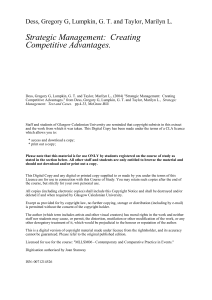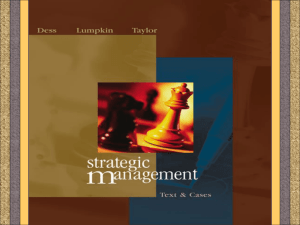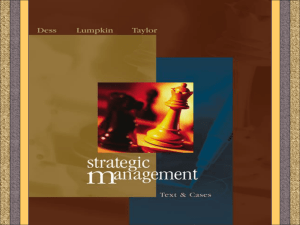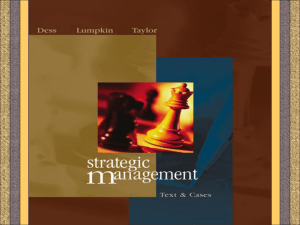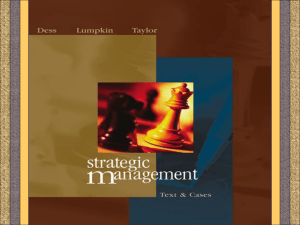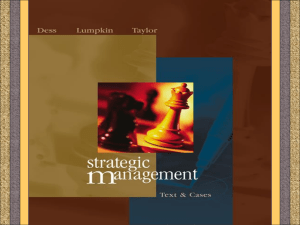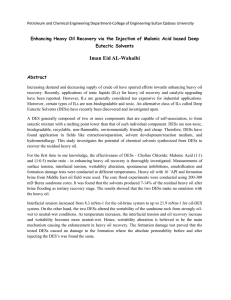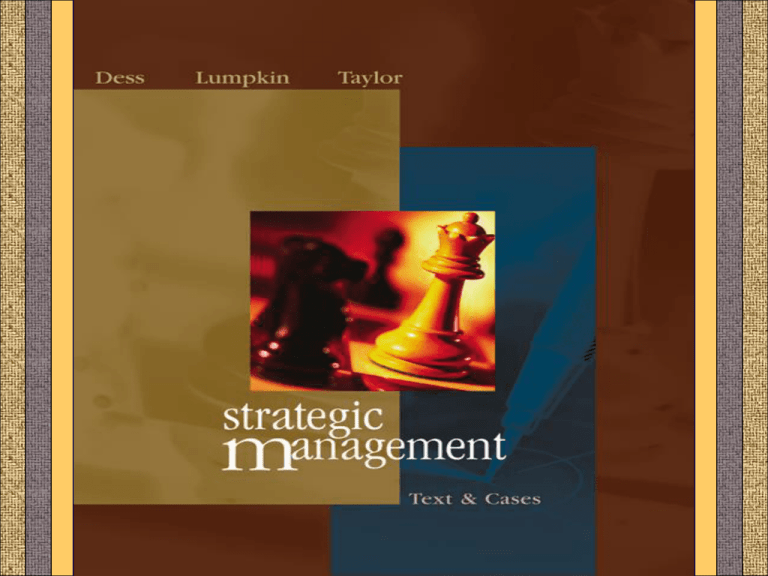
4-1
STRATEGIC MANAGEMENT
CHAPTER 4
Gregory G. Dess and G. T. Lumpkin
Chapter 4
Recognizing a Firm’s
Intellectual Assets:
Moving Beyond A
Firm’s Tangible
Resources
McGraw-Hill/Irwin
Copyright © 2004 by The McGraw-Hill Companies, Inc. All rights reserved.
4-3
Learning
Objectives
After studying this chapter, you should have
a good understanding of:
• Why the management of knowledge professionals and knowledge
itself is so critical in today’s organizations
• The importance of recognizing the interdependence of attracting,
developing, and retaining human capital
• The key role of social capital in leveraging human capital within and
across the firm
• Why teams are critical in combining and leveraging knowledge in
organizations and how they can be made more effective
• The vital role of technology in leveraging knowledge and human
capital
• How technology can help to retain knowledge even when employees
cannot be retained by the organization
• How leveraging human capital is critical to strategy
STRATEGIC MANAGEMENT
CHAPTER 4
Gregory G. Dess and G. T. Lumpkin
4-4
Exhibit 4.1
Ratio of Market Value to Book Value
for Selected Companies
Market
Value
($billions)
Book Value
($billions)
Ratio of
Market
To Book
Value
.4
13.9
.9
15.4
Oracle
10.9
80.7
6.5
12.4
Microsoft
25.3
327.4
41.4
7.9
Intel
33.7
177.0
32.5
5.4
4.6
3.3
2.2
1.5
184.6
30.5
20.6
1.5
14.4
3.0
3.6
Company
Annual Sales
($billions)
Ebay
Nucor (Steel)
General
Motors
Corp.
Goodyear
Tire &
Rubber Co.
.83
Note: The data on market valuations are as of November 5, 2001. All other financial data is based
on the most recently available balance sheets and income statements.
STRATEGIC MANAGEMENT
CHAPTER 4
Gregory G. Dess and G. T. Lumpkin
4-5
The Factors of Production
• Land
• Labor
• Capital, and
• Knowledge
STRATEGIC MANAGEMENT
CHAPTER 4
Gregory G. Dess and G. T. Lumpkin
4-6
Components of Intellectual Capital
• Human Capital
• Social Capital
The individual skill sets and
work-related capabilities
of employees
The formal and informal
relationships within the
firm
The values and attitudes of
individual employees
Unique resources
Interaction, sharing and
collaboration
Allows the firm to combine
and leverage its human
capital
Unique bundles of resources
STRATEGIC MANAGEMENT
CHAPTER 4
Gregory G. Dess and G. T. Lumpkin
4-7
Exhibit 4.2
Human Capital:
Three Interdependent Activities
Attracting
Developing
Human
Human
Capital
Capital
Retaining
Human
Capital
STRATEGIC MANAGEMENT
CHAPTER 4
Gregory G. Dess and G. T. Lumpkin
4-8
Exhibit 4.3
An Excerpt From GE’s 360-Degree
Leadership Assessment Chart
Vision
• Has developed and communicated a clear, simple, customer-focused
vision/direction for the organization.
• Forward-thinking, stretches horizons, challenges imaginations.
• Inspires and energizes others to commit to Vision. Captures minds. Leads
by example.
• As appropriate, updates Vision to reflect constant and accelerating
change affecting the business.
Customer/Quality Focus
Integrity
Accountability/Commitment
Communication/Influence
Shared Ownership/Boundary-less
Team Builder/Empowerment
Source:
Adapted from
Slater, R.
1994. Get
Better or Get
Beaten. Burr
Ridge, IL:
Irwin
Professional
Publishing;
152-155.
Knowledge/Expertise/Intellect
Initiative/Speed
Global Mind-Set
Note: This evaluation system consists of ten “characteristics” – Vision, Customer/Quality Focus,
Integrity, and so on. For each of these characteristics there are four “performance criteria.” For
illustrative purposes, the four performance criteria for “Vision” are included.
STRATEGIC MANAGEMENT
CHAPTER 4
Gregory G. Dess and G. T. Lumpkin
4-9
Exhibit 4.4
(adapted)
Employee Benefits at Leading-Edge
Firms
MBNA (Wilmington, Del.) This credit card issuer is
proud of its beautiful facilities with on-site day
care, dry cleaning, shoe repair, and beauticians.
When an employee’s child is born or if they adopt,
MBNA contributes $2,500 toward his/her
education.
Sources: Branch, S.
1999. The 100 best
companies to work
for in America,
Fortune, January
11:118-114;
Bennett, S. 2000.
Working Woman:
September, 46.
SAS Institute (Cary, N.C.): SAS offers a 35-hour
week, childcare for $250 a month, a free on-site
medical clinic, and twelve holidays a year, plus a
paid week off between Christmas and New Year’s.
STRATEGIC MANAGEMENT
CHAPTER 4
Gregory G. Dess and G. T. Lumpkin
4-10
Exhibit 4.5
(adapted)
Microsoft Employees Who Have Left
the Company for Other Businesses
COMPANY
WHAT IT DOES
DEFECTORS FROM
MICROSOFT
Crossgain
Builds software
around XML
computer language
23 of 60 employees
Check
Space
Builds online
Company says ‘a good
payment service for chunk’ of its 30
small businesses
employees
Avogadro
Builds wireless
notification
software
Eight of 25 employees
Source: Buckman, R. 2000. Tech defectors from Microsoft resettle together. Wall Street Journal, October 16: B6.
STRATEGIC MANAGEMENT
CHAPTER 4
Gregory G. Dess and G. T. Lumpkin

